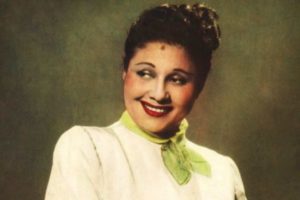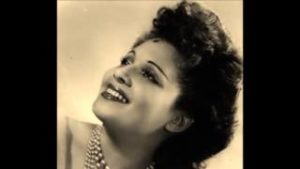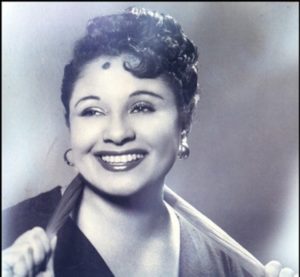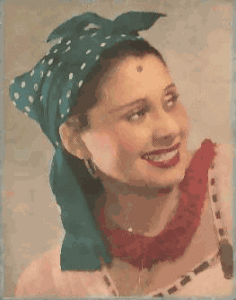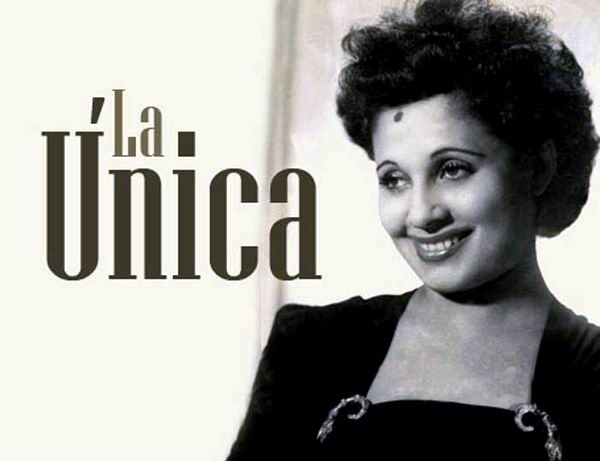 “LA ÚNICA” DE CUBA, RITA MONTANER.
“LA ÚNICA” DE CUBA, RITA MONTANER.
De voz bien timbrada, de soprano, cantaba a capela sin previa entonación, su gusto por hacerlo en el ámbito familiar de su casa devinieron su primer escenario, aunque quiso ser siempre “visible” y lo fue.
Rita Aurelia Montaner Facenda o simplemente Rita Montaner, nombre artístico, nació en el habanero municipio de Guanabacoa el 20 de agosto de 1900. Fue una de las más grandes artistas cubanas del teatro, la radio, el cine y la televisión.
Hija de un distinguido médico de la villa, pronto la niña estudió piano en el Conservatorio Peyrellade y realizó estudios de canto con el maestro Pablo Morales. En 1917, se graduó de piano, canto y armonía, realizó conciertos con fines benéficos y desde entonces, ligada a prestigiosos artistas y músicos nacionales y de Estados Unidos, Europa y América, dio a conocer su arte.
Grabó para la Columbia, cantó en la transmisión inaugural de la radio en Cuba, estrenó el Mamá Inés en la revista Niña Rita, se fue a París, triunfó sustituyendo a la célebre Raquel Meller en esa capital, convirtiéndose en embajadora de lo cubano. Rita cantó con Al Jolson y alternó con María Luisa Landín, Libertad Lamarque, Pedro Vargas entre otros grandes del pentagrama internacional. Se movió en lo lírico y en lo popular y se hizo aplaudir en el cine. Muy gustado fue en la radio su personaje de “lengua lisa” con el cual denunció a los corruptos del gobierno y sus bromas picantes tocaban la llaga de la realidad nacional.
https://youtu.be/fYnY7K2a0xw
La televisión la tuvo como una de sus figuras principales al tiempo que los registros sonoros y su aparición en filmes, generalmente coproducciones cubano-mexicanas, dan fe de la autenticidad de una mulata llena de gracia, controvertida y de lengua suelta pero criolla.
Deslumbró a los auditorios que solo concebían a la vedette envuelta en plumas o como bailarina exótica, imitó a Josephine Baker desde los años 20, ella, a quien le gustaba muy poco ser imitada.
Rita fue única. Tanto en París como en Nueva York, en México o en Buenos Aires, puso muy alto «el corazón prieto y apretado de la Isla».
Le llamaron «Rita de Cuba» y ya en 1942 hacía rato que era conocida por el calificativo de “La Única». Rita de Cuba, Rita la Única. “No hay tan adecuado modo de llamarla, si ello se quiere hacer con justicia -escribió Nicolás Guillén. De Cuba, porque su arte expresa hasta el hondón humano lo verdaderamente nuestro. La Única, pues solo ella, y nadie más, ha hecho del “solar” habanero, de la calle cubana, una categoría universal”.
https://youtu.be/6Z8eNHTY3LY
Para el compositor cubano Ernesto Lecuona ella fue «el arte en forma de mujer»; sus cualidades vocales eran excepcionales y fue además una pianista de línea. «Anunciarla era tener el teatro lleno por anticipado».
Supo además adaptar su voz a las estampas costumbristas cuando ya el repertorio lírico se le hizo demasiado arduo.
En 1955 logró poner a La Habana a sus pies nuevamente cuando interpretó Madame Flora la ópera La Médium , de Gian Carlo Menotti, en la sala Hubert de Blanck y en la cima de su trayectoria el cáncer le gana la batalla y tres años despúes su voz se apagó para siempre.
Falleció el 17 de abril de 1958 y una ola de dolor recorrió el país. La televisión nacional le rindió un homenaje sin precedentes.
 “THE ONLY ONE” OF CUBA, RITA MONTANER.
“THE ONLY ONE” OF CUBA, RITA MONTANER.
With a well-stamped, soprano voice, she sang a capella without prior intonation, her taste for doing it in the family environment of her house became her first stage, although she wanted to be always “visible” and she was.
Rita Aurelia Montaner Facenda or simply Rita Montaner, stage name, was born in the Havana municipality of Guanabacoa on August 20, 1900. She was one of the greatest Cuban artists of theater, radio, film, and television.
Daughter of a distinguished doctor of the town, soon the girl studied piano at the Peyrellade Conservatory and conducted singing studies with maestro Pablo Morales. In 1917, she graduated in piano, singing, and harmony, performed concerts for charity and since then, linked to prestigious artists and national musicians and the United States, Europe and America, he made her art known.
She recorded for Columbia, sang in the inaugural radio broadcast in Cuba, premiered Mama Inés in the magazine Niña Rita, went to Paris, triumphed replacing the famous Raquel Meller in that capital, becoming an ambassador of the Cuban. Rita sang with Al Jolson and alternated with María Luisa Landín, Libertad Lamarque, Pedro Vargas among other greats of the international pentagram. He moved in the lyrical and the popular and was applauded in the cinema. He was very liked on the radio his character “smooth tongue” with which he denounced the corrupt government and his spicy jokes touched the wound of national reality.
Television had her as one of its main figures while the sound recordings and its appearance in films, usually Cuban-Mexican co-productions, attest to the authenticity of a mulatto woman full of grace, controversial and of loose but Creole language.
It dazzled the audiences that only conceived the vedette wrapped in feathers or as an exotic dancer, imitated Josephine Baker since the 1920s, she, who liked very little to be imitated.
Rita was unique. Both in Paris and in New York, in Mexico or in Buenos Aires, he set very high “the tight and tight heart of the Island.”
They called her “Rita de Cuba” and in 1942 she was known by the name of “La Única”. Rita from Cuba, Rita the One. “There is no adequate way to call it if it is to be done with justice,” wrote Nicolás Guillén. From Cuba, because his art expresses up to the human depth what is truly ours. The Only one, because only she, and nobody else, has made the “solar” Havana, of the Cuban street, a universal category.
For the Cuban composer Ernesto Lecuona, she was “art in the form of a woman”; her vocal qualities were exceptional and she was also a line pianist. “To announce her was to have the theater full in advance”.
She also knew how to adapt her voice to the costumbristas prints when the lyric repertoire was already too hard.
In 1955 he managed to put Havana at her feet again when she played Madame Flora the opera La médium, by Gian Carlo Menotti, in the Hubert de Blanck hall and at the top of her career the cancer wins the battle and three years later her voice it was extinguished forever.
She died on April 17, 1958, and a wave of pain swept the country. The national television paid her an unprecedented tribute.
Agencies/ EHC/ Guadalupe Yaujar/ Bárbara Gómez/ Excerpts/ Internet Photos/ YouTube/ Arnoldo Varona/ www.TheCubanHistory.com
THE CUBAN HISTORY, HOLLYWOOD.
OVER 7,000 ARTICLES ABOUT CUBA. (SEARCH > www.TheCubanHistory.com



 < "THE ONLY ONE" ("La Única") OF CUBA, RITA MONTANER. Videos.
< "THE ONLY ONE" ("La Única") OF CUBA, RITA MONTANER. Videos.